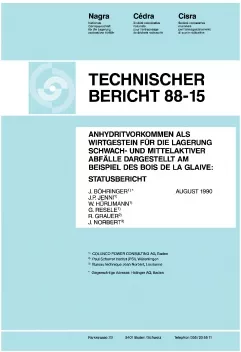
Technischer Bericht NTB 88-15
Anhydritvorkommen als Wirtgestein für die Lagerung schwach- und mittelaktiver Abfälle dargestellt am Beispiel des Bois de la Glaive:Statusbericht
Anhydrite may represent a close-to-ideal host rock for a radioactive waste repository. It generally has a very low hydraulic permeability and also tends to alter into gypsum in the presence of water, which can result in the effective sealing of open water flow paths. Its structural engineering properties are also excellent.
However, as a potential host rock, anhydrite does have some disadvantages. The positive aspects listed above only apply if the anhydrite is relatively pure and if the formation does not contain any extensive inclusions of allochthonous rock. Anhydrite and, to an even greater extent, its alteration product gypsum, are more soluble in water than the other potential host rocks being investigated in Switzerland. Gypsum, and under extreme conditions anhydrite, are also subject to karstification.
The potential site location under consideration at Bois de la Glaive in the lower Rhone valley is presumed to consist of a thick anhydrite mass. All the existing information tends to indicate that this is a potentially suitable disposal site which is worthy of further investigation.
Performing a safety analysis for a repository in anhydrite requires that specific processes are modelled quantitatively. This applies in particular to the kinetics of dissolution and gypsification processes, the development of superficial and lateral gypsous zones over long periods of time and the influence of allochthonous rock inclusions, of tectonic events and of erosion processes. This report summarizes all the information currently available and attempts to quantify as far as possible the processes mentioned above. The conclusions apply both to anhydrite in general and to the situation at Bois de la Glaive in particular. The report will form a working basis for future safety analyses and for the planning of both field and laboratory investigation programs.
It is impossible at this stage to fully quantify the relevant processes mentioned previously. Although the physical and chemical equilibrium properties of the system anhydrite/gypsum/water/air are well-known and the modelling approaches used in the literature for describing dissolution processes can be considered reliable, there is still an element of uncertainty with respect to the important processes and modelling approaches involved in gypsification, the development with time of superficial gypsum coatings and glacial erosion. In addition to this, there is very little site-specific information, and therefore no reliable quantitative site-specific statements can be made concerning any of these processes.
